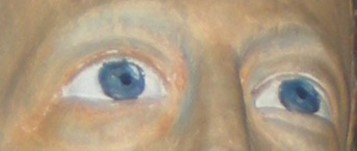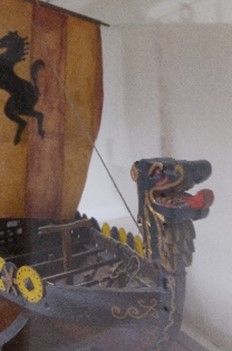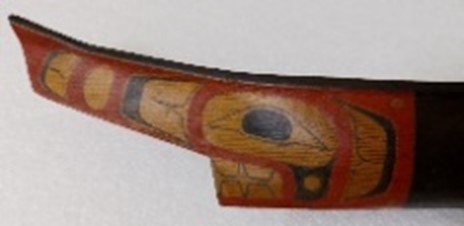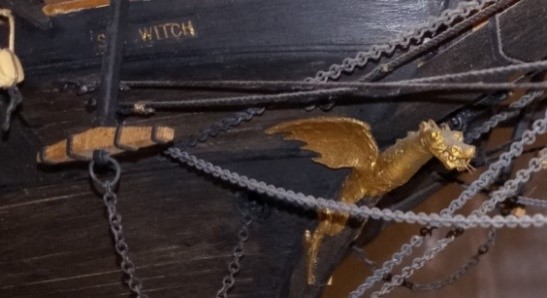The Eyes Have It

Figureheads Through History
Eyes. That’s what figureheads are all about. Eyes to see the distant shore. Eyes to spot potential dangers. Eyes to guide through stormy seas. Eyes to find the way there and home again. Eyes painted on the starboard and port bow. Eyes staring out from the painted image of mythical, spiritual, of real animals or people. The eyes of a figure carved into the bow. For thousands of years, eyes were considered the most important characteristic of any ornamentation found on a ship’s bow.
Those eyes kept watch over their vessel and crew. They looked out from a figure that identified the vessel, reflecting its name for the illiterate or foreign speakers. Wild and fierce eyes served to intimidate enemies. Commanding and domineering eyes represented families, powerful owners, or nations. Vigilant and wary eyes protected the vessel and crew. Seductive and alluring eyes gazed out at the sea gods, beguiling and beseeching them calm the waves and grant the vessel safe passage.

SAFR994 - Viking long shop model - NPS
From the earliest painted eyes to the elaborately carved figurehead, bow decorations have held great meaning and importance to the men who sailed the seas. The Phoenicians adorned the prows of their oared galleys with wooden carvings of various animals, birds, and deities, each declaring an important characteristic of the ship and crew. A horse at the bow of a Phoenician vessel boasted of its speed. Greek vessels with a boar’s or lion’s head proclaimed acute vision and ferocity. Egyptians relied on holy birds for protection.

SAFR-02702.55 Pacific Northwest Indigenous canoe model
Roman centurions at the bow spoke of great valor in battle and instilled fear in their enemies. Dragon or serpent heads rising from the bow of Viking long boats protected their vessels and crews. Haida and Tlingit painted large-eyed animals such as ravens, eagles, beavers, and killer whales on the bows of their large sea-going canoes based upon their family crest, thus identifying the vessel’s owner from a distance. During the Knobaung Dynasty (1752 to 1885) in Burma, mythical figureheads distinguished the several types of royal barges allocated to various members of the royal court.
SAFR 16662 drawing close-up of a Chinese warships' bow - NPS
Northern European shipbuilders relied on bulls (strength and courage), dolphins (agility in water), dragons (protectiveness) serpents (fierce fighting nature), and swans (grace, mobility, swiftness, and nobility) to illustrate the various characteristics endowing their ships. In England, patriotic emblems, including unicorns and lions, carved busts or full body figures of naval heroes or royalty exemplified the national pride, strength, might and power of that rising maritime and political country. And then there were the figureheads of women – scantily clad women more often than not. These provocative figures were not for the sailors’ admiration, but rather for the pleasure of the sea gods, Neptune and Poseidon, in hopes they would grant the ship safe passage.
SAFR-2702.2 Close up of a figurehead on model of the clipper ship Sea Witch - NPS
Although figureheads adorned vessels from the earliest times, they hit their height of popularity between 1750 and 1870 when they appeared on the bow of naval and merchant ships worldwide. In the midst of those years, American and English clipper ships with their evocative names and beautifully carved figureheads dominated the oceans. Names like Comet, Eagle Wing, Flying Cloud, Lighting, Ocean Express, Sea Witch, Flying Fish, Northern Light, Shooting Star, and Witch of the Wave, challenged the men who carved figureheads to create amazing works of art to travel the world’s watery highways.For some reason, shipbuilders along America’s Pacific Coast never included figureheads in their designs. Instead, they decorated the bows of their vessels with carved prows, trailing boards and beakheads. These decoratively carved and gilded or painted boards led aft from the stem and originally helped to support the figureheads.

Decorative Prow of the C.A. THAYER - NPS
During the waning years of the 19th century, ship construction shifted from wooden sailing vessels with their gracefully curved bows to ships built of iron and steel designed with blunt and vertical bows, leaving no place to mount a figurehead. With this change figureheads rapidly disappeared from new construction. Today figureheads surviving from the age of sail reside in museums around the world. Meanwhile handful of talented artisans still find work carving exact replica figureheads for museum ships, modern versions of historic ships, and collectors of maritime folk art.